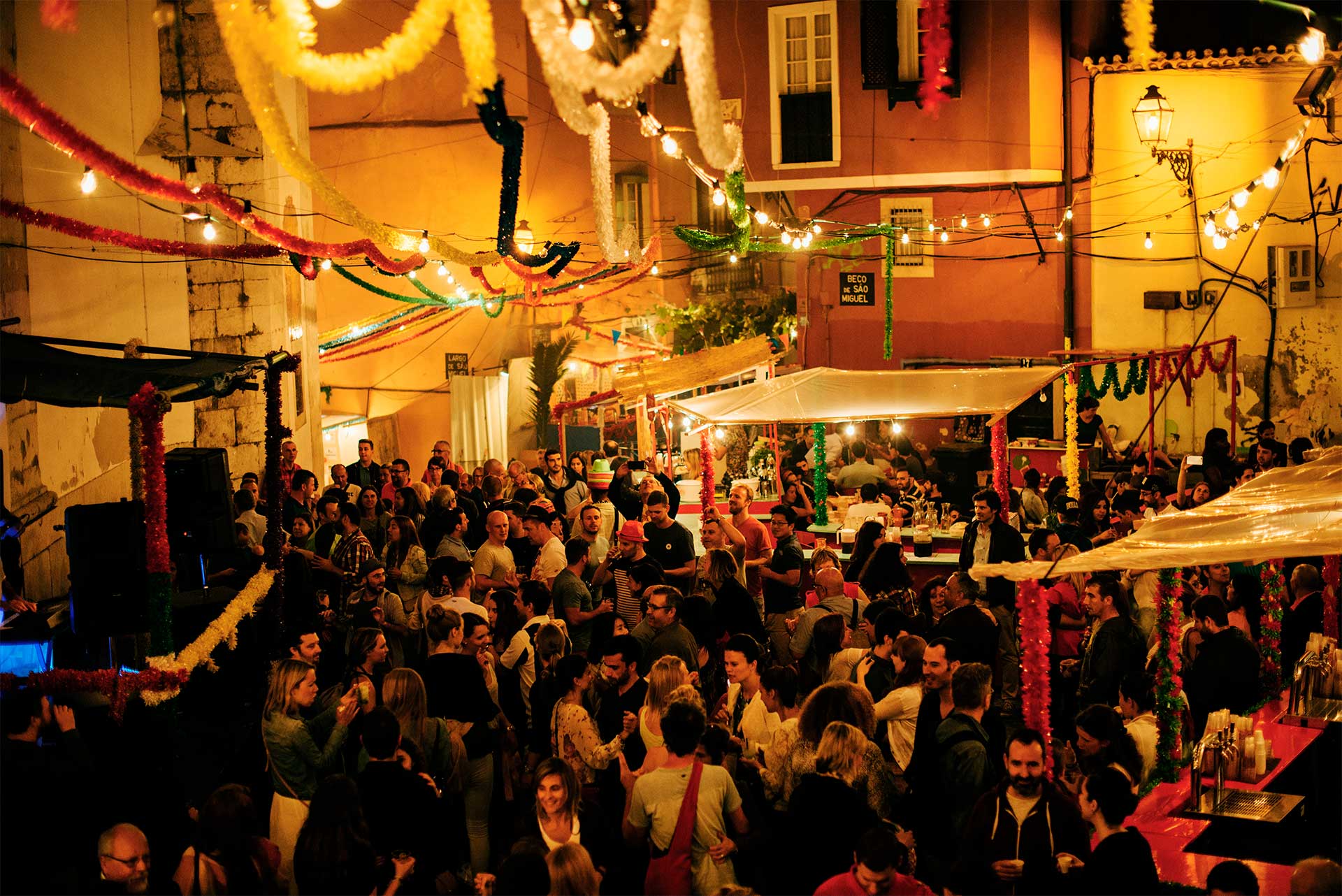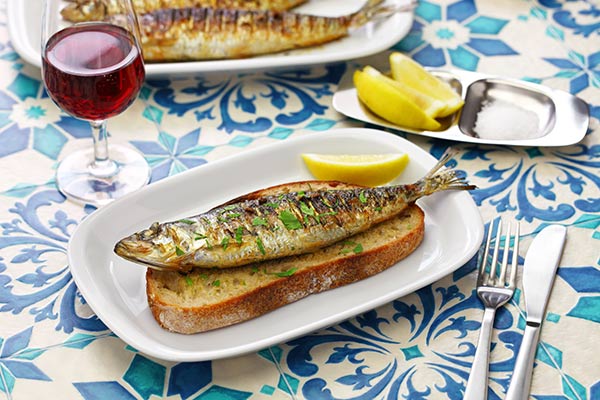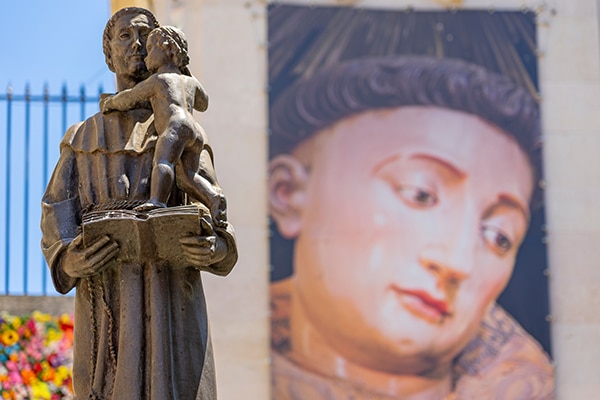Lisbon’s Santos Populares Festival: how to make the most of it
Dec. 15 2023

The “Santos Populares” Festival is the most celebrated event in the Portuguese capital. In this article, we will tell you everything you need to know to make the most of it.
June is the quintessential month of the Lisbon Festivities (Festas de Lisboa). It’s no coincidence: the Popular Saints (Santos Populares) are celebrated this month, including St. Anthony – the patron saint of the capital – but also St. John and St. Peter. The celebrations take place on the 13th, 24th and 29th of June, respectively, but throughout the month, you can wander around the city, see the typical decorations and take part in the festivities in each neighbourhood.
There are many symbols associated with this season: from globe basil to sardines; from the parade to folk music, including costumes and allegorical decorations. In Lisbon, the celebration of the city’s patron saint goes even further, including St. Anthony’s weddings, alluding to his reputation as a matchmaker.
The night of the 12th of June is the highlight of the celebrations, so if you want to take part, it’s best to arrive the day before, if not earlier. If you want to experience the festivities up close, Solar do Castelo hotel offers a privileged location. From there, you can walk to various neighbourhoods in the city – or stay close to the Castle and be part of the tide of people that invades it that night.

4 popular saints’ symbols and what they mean
This is a season rich in symbolism, but the meaning of the symbols is not always obvious to those who take part in the festivities. Read on to discover the history of four symbols that characterise Lisbon’s Santos Populares.
1) Grilled sardines on bread
There’s no room for doubt: those who go out to experience the Santos Populares will be eating grilled sardines, preferably on bread. You can also order a “caldo verde” – a typical creamy potato-based soup with thinly sliced kale and a slice of Portuguese chouriço sausage.

The tradition of eating grilled sardines during the Santos Populares festival began in Lisbon and later, in the 1940’s, spread to northern Portugal. In the book Culinária Portuguesa (Olleboma, 1936), the sardine season is recorded from May to October.
The tradition of catching sardines at this time, combined with the popular nature of these festivals, explains why this fish is one of the stars of the celebrations: in the late 19th and early 20th centuries, the large fish were destined for wealthy tables, while the small ones for more modest dishes.
2) Globe basil and a folk song
Santo António, Santo António / Saint Anthony, Saint Anthony
Que bonito que tu és / Your beauty no one can beat
Vou comprar um manjerico / I’m going to buy a globe basil
E vou pô-lo a teus pés / And I’m going to put it at your feet
It’s not easy to find answers as to when and how the globe basil, which belongs to the basil family, became a symbol of the Santos Populares. What is certain is that the aromatic plant, known as the “lovers’ herb”, symbolises love and offering it can be a symbol of ephemeral love, given that it is a plant with a short life cycle.

The fact that it is an aromatic plant also gives it an excellent setting in the context of the Santos Populares: its pleasant aroma, which, according to popular wisdom, should only be smelt indirectly by placing your hand on its small, oval leaves, can also have an insect repellent effect.
3) Marchas populares parade
Every year, each neighbourhood in the city prepares a march for the annual “Marchas Populares” parade, which takes place on the evening of the 12th of June on Avenida da Liberdade. Throughout the year, a team from each neighbourhood engages in preparing a set of original pieces (music and lyrics; choreography and costumes) to be presented to the public. The party, broadcast live on television, is truly contagious. Each neighbourhood chooses a godfather and godmother for their parade – usually public figures, to make their work more visible. The winners, chosen by the jury, are announced at the end of the night.

The tradition dates back to 1932, when the first popular parades were officially organised in Lisbon. They became such a symbol of the capital that they starred in some scenes in the film Canção de Lisboa (Cottinelli Telmo, 1936). Because they were associated with the dictatorial regime, they were interrupted by the Carnation Revolution (25th of April 1974), only to return in 1980.
4) Casamentos de Santo António (Weddings of St. Anthony)
St. Anthony, the patron saint of Lisbon, is also considered the “matchmaker saint”, so stories abound about people who found love thanks to his help. For example, according to a 17th century Portuguese tradition, a woman desperate to find a husband threw her statue of St. Anthony out of the window, hitting a soldier who was passing by in the street at the time. The story goes that, after being rescued by the woman herself, the soldier fell in love with her and they ended up getting married.

Taking advantage of the patron saint’s fame, Lisbon City Hall organises the weddings (Casamentos de Santo António) every year. In practice, 16 couples are chosen to tie the knot on the 12th of June and end the day parading down Avenida da Liberdade, in what is now also a tradition of the Popular Saints. The ceremony is divided between the Lisbon Cathedral for religious weddings and the Great Hall of the City Hall for civil weddings. The first edition took place in 1958, in the Church of St Anthony, uniting 26 couples. The initiative was interrupted with the 1974 Revolution and resumed in 1997.
Now that you know all about Lisbon’s most festive season, we hope you’ll be excited to experience it for yourself. Make sure you wear cool clothes and comfortable shoes, as you’ll be walking around the various neighbourhoods of the “city of seven hills”. Whether you want to start the evening on Avenida da Liberdade, head up to Bairro Alto and Bica and across to the Castle or in the opposite direction, Lisbon Heritage Hotels has an accommodation option for you.
If you prefer a quieter pace and no crowds, you can choose to stroll around during the day. The festivals in the various neighbourhoods go on and allow you to experience the flavours and aromas of the Santos Populares Festival in a more familiar and equally lively version. In this case, don’t forget your hat and sunscreen: this time of year is very hot.
